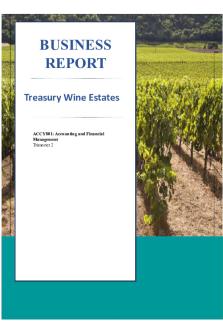Wine Tasting 1 PDF

| Title | Wine Tasting 1 |
|---|---|
| Course | Australia In The Wine World |
| Institution | University of Melbourne |
| Pages | 3 |
| File Size | 107.1 KB |
| File Type | |
| Total Downloads | 8 |
| Total Views | 151 |
Summary
Download Wine Tasting 1 PDF
Description
The first is very practical: persistence of flavour. Persistence means how long the flavour lasts after you spit or swallow. The longer that flavour lasts, assuming it’s a positive flavour and not a negative fault, is a fairly simple indication of quality. Basically this is because there must have been a greater concentration of flavour in the grapes at time of harvest. This concentration, combined with winemaking skill, has then been translated into the glass. Persistence and definition of flavour are also important when trying to match food and wine. A wine of little or no flavour would be impossible to match with any food. The second quality factor is: balance. Balance usually refers to a harmony between the structure and the flavour of the wine. In other words, the amount of acid, bitterness, or sweetness in a wine should relate favourably to the intensity of the flavours and aromas of the variety, or varieties, used in that wine. Thus a young shiraz that has great intensity of flavour may not have balance unless that is matched by a corresponding amount of acid and tannin. Conversely an aged red wine that has quite delicate and understated flavours and at the same time a structure which is soft and subtle must also be in balance. This second case is what you hope to see in great aged wines. New World Vs Old World
New world: the world discovered by the explorers of the 16th and 17th Centuries. When those intrepid Spaniards, Portuguese and Dutch explorers landed in the “New World” Used stainless steel for fermentation, new wood for storage and used refrigeration, pressure and cleanliness to prevent microbial spoilage Old world: those countries where the grape vine, and hence wine, is considered “native”. Eg Europe The use of old wooden vessels for fermentation, storage in this old wood for extended time before bottling and a widespread belief that the alcohol in the wine is able to kill any undesirable micro-organism. This in general terms, gives the wine earthy, complex flavours that taste little like the original grape varieties.
Lecture 2.3 Terroir: natural conditions which influence the biology of the vine and thus the grape. Terroir is the coming together of the climate, soil and the landscape. It is the combination of an infinite no of factors, temp by night and day, rainfall, hrs of sunlight, slope and drainage. Branding, association, convincing consumers to purchase wine from a specific region. For global market, to ensure people know where it comes back. Marketing and regional identity -
restricting supply in a growing market legality of names ownership of terroir export and the EU protection of the trademarks QWPSR (quality wine produced in specific regions) the EU definition Certain wines are associated with wines from a specific region, especially in the old world
Australian “terrior” LIP – Label integrity program -
enforced by the Australian Grape and Wine Authority (AGWA) since 1990 current name since July 2014 annual audits 85% accuracy on labels variety, vintage, region has to include label for export, and pregnant lady and heavy machinery. Different laws control the labels, labels have to be different for each country, even each state in the US.
GI System -
geographic indicator zone geographic features that means it “unique” eg: lake that affects climate. Adelaide hills the slopes altitude makes it unique 500 tonnes from 5 separate vineyards of 5 hectares each at least super regions and sub regions less region, less chance of demand and competition wine Australia and “regional heroes”- those who have been making wine for many generations, specialty for a different wine
Shiraz Scents: spices cinnamon, clove, nutmeg pepper mint/eucalypt blackberry/dark cherry choc flavours: fruit cake, fruit cordial, blackberry, peppery, meaty, beef stock, black olive merlot scents: herbaceous aromas of ripe small red fruits muscatels roses sappy coffee mocha flavours: plum, fruit cake, mulberry, blackberry, blackcurrant, rhubarb, herbal, tobacco pinot noir not much tannin scents: raspberry, cherry, plum cinnamon herbs perfume stewed plum rhubarb flavours: strawberry, red cherry, raspberry, earthy, cow yard, gamey, mushroom sangiovese tannin dryness savory intense fruit goes well with osso bucco (rich/sweet meat dish)...
Similar Free PDFs

Wine Tasting 1
- 3 Pages

Zoom tasting 1 Info sheet
- 1 Pages

WINE Homework
- 3 Pages

70085333-Fermentasi-Wine
- 14 Pages

Fruit WINE Making
- 4 Pages

LAPORAN PRAKTIKUM WINE
- 12 Pages

Amy wine house- Bipolar Disorder
- 2 Pages

Blood into Wine Film Notes
- 5 Pages

Jaepa Wine and cider assesment 2
- 3 Pages
Popular Institutions
- Tinajero National High School - Annex
- Politeknik Caltex Riau
- Yokohama City University
- SGT University
- University of Al-Qadisiyah
- Divine Word College of Vigan
- Techniek College Rotterdam
- Universidade de Santiago
- Universiti Teknologi MARA Cawangan Johor Kampus Pasir Gudang
- Poltekkes Kemenkes Yogyakarta
- Baguio City National High School
- Colegio san marcos
- preparatoria uno
- Centro de Bachillerato Tecnológico Industrial y de Servicios No. 107
- Dalian Maritime University
- Quang Trung Secondary School
- Colegio Tecnológico en Informática
- Corporación Regional de Educación Superior
- Grupo CEDVA
- Dar Al Uloom University
- Centro de Estudios Preuniversitarios de la Universidad Nacional de Ingeniería
- 上智大学
- Aakash International School, Nuna Majara
- San Felipe Neri Catholic School
- Kang Chiao International School - New Taipei City
- Misamis Occidental National High School
- Institución Educativa Escuela Normal Juan Ladrilleros
- Kolehiyo ng Pantukan
- Batanes State College
- Instituto Continental
- Sekolah Menengah Kejuruan Kesehatan Kaltara (Tarakan)
- Colegio de La Inmaculada Concepcion - Cebu






